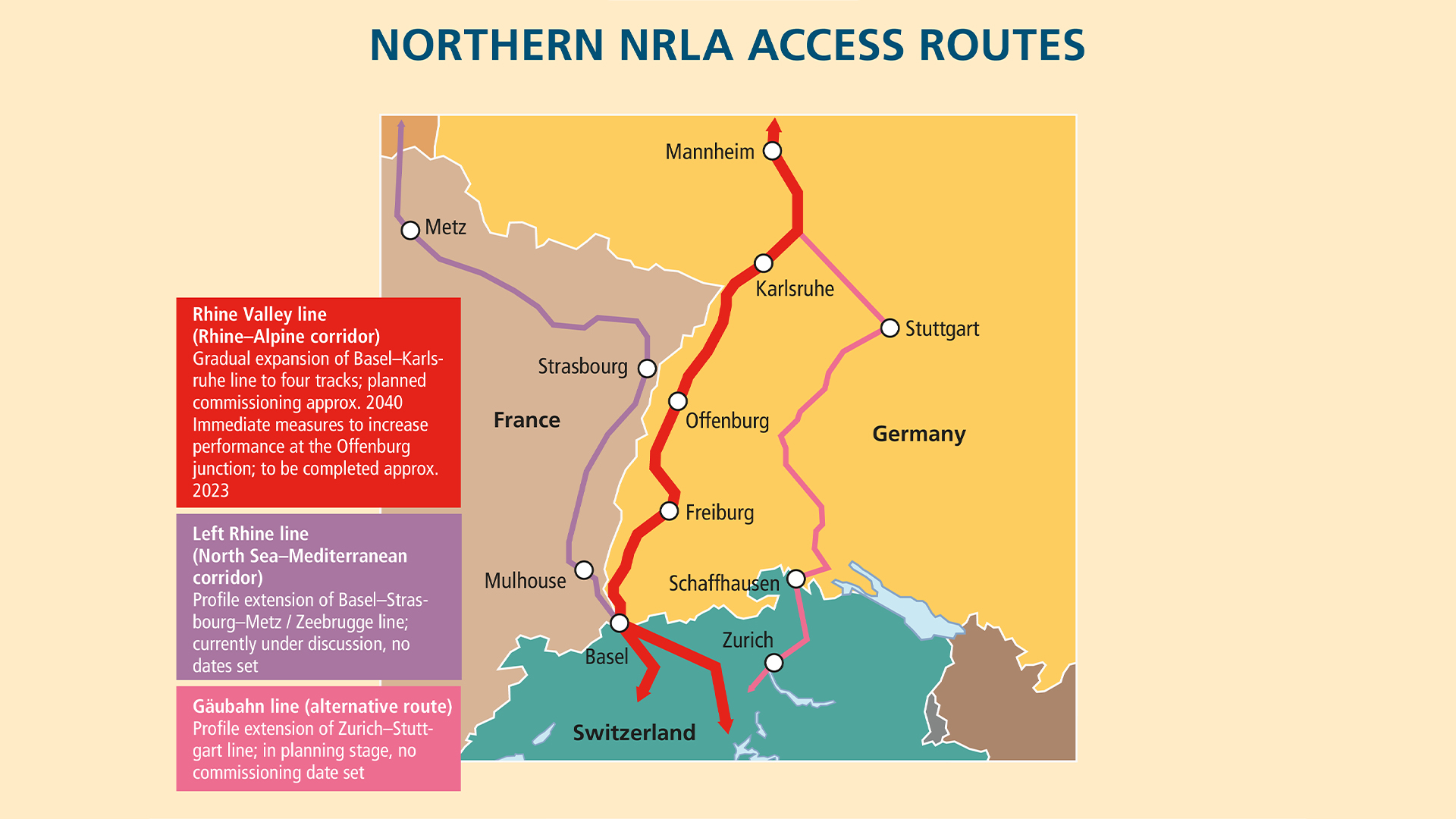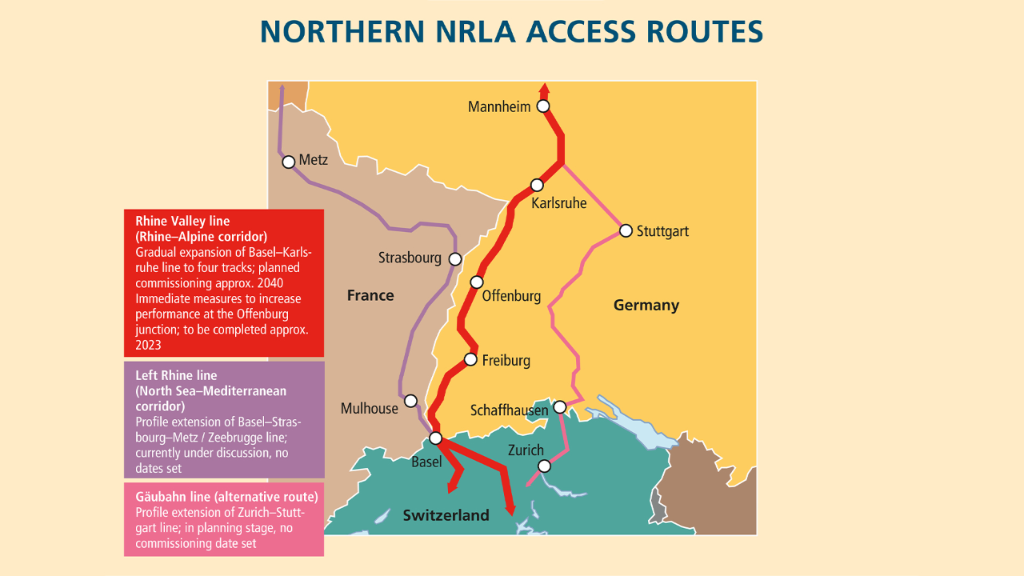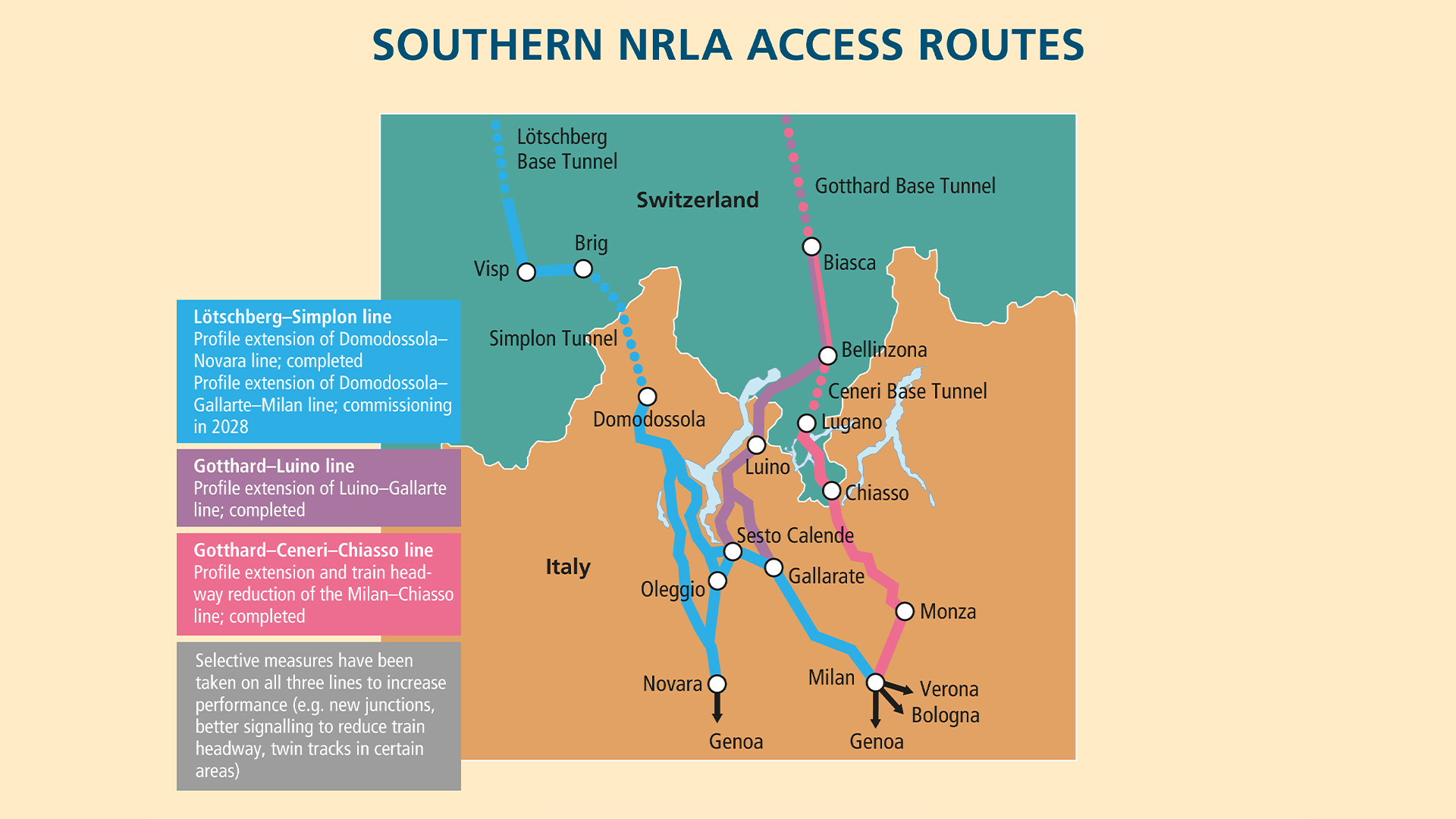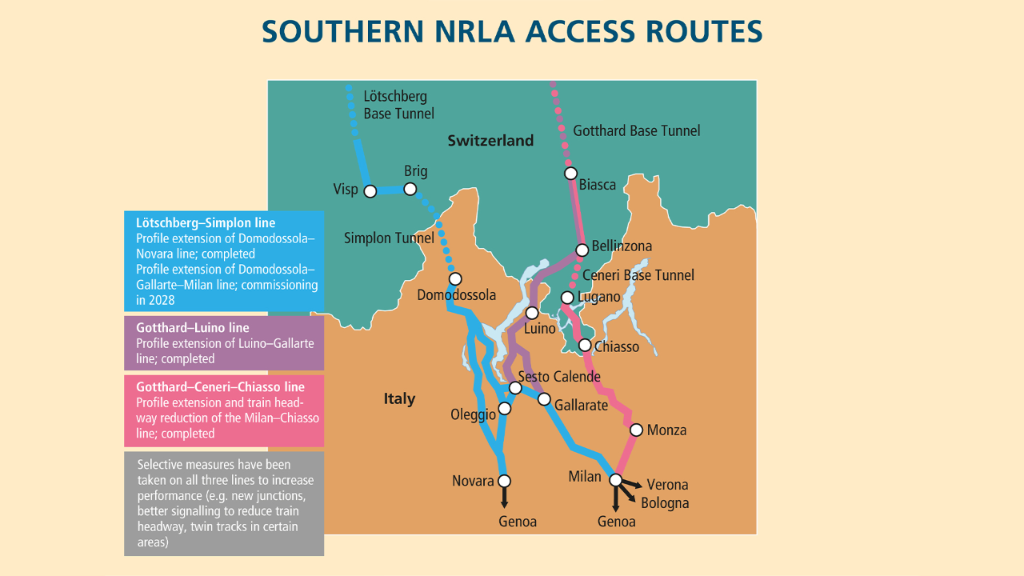The NRLA is the main instrument in Switzerland's modal shift policy. Three base tunnels form a flat-track railway through the Alps, saving energy, costs and time in freight transport.

© SBB
The New Rail Link through the Alps (NRLA) is an epic achievement and has been in operation since 2020. By building three base tunnels through the Alps and upgrading the access routes, Switzerland has managed to bring the north and south of the country – as well as Europe – closer together. Journey times between the north and south have been reduced by up to one hour for passengers, whilst the flat link increases rail’s environmentally friendly credentials for freight traffic.
NRLA’s constituent parts
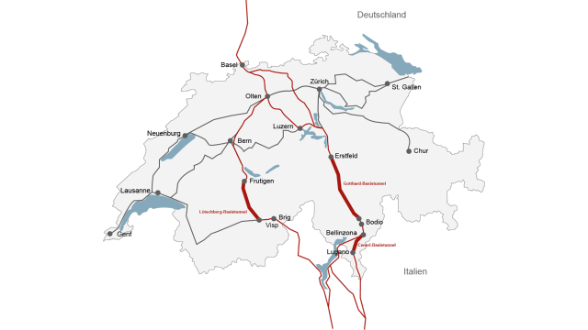
© FOT
Lötschberg Base Tunnel
The Lötschberg Base Tunnel is 34km long and has been in operation since 2007. It stretches from the Bernese Oberland to the Valais. From there the route continues to northern Italy via the Simplon tunnel. Construction took eight years and costed around CHF 5.3 billion (current costs including interest and VAT). The Lötschberg Base Tunnel consists of two separate tubes, apart from one section of the western tube of around 6km. To save money, only one third of the tunnel was initially developed with dual tracks. The remainder of the second tube serves as a rescue tunnel. In 2019 Parliament approved the completion of the remaining part of the second tube as part of the 2035 expansion step, costing around CHF 0.9 million. In 2024, parliament adjusted this and decided on the full expansion.
The Lötschberg Base Tunnel has shortened journey times between major destinations in German-speaking Switzerland and the Valais and northern Italy by up to one hour. Passenger trains travel every hour (and every half hour at peak times) through the Lötschberg Base Tunnel. It is also very important for freight traffic: the Lötschberg Base Tunnel can handle up to 110 freight trains every day.
Gotthard Base Tunnel
At 57km, the Gotthard Base Tunnel has overtaken the Seikan tunnel in Japan (53.8km) as the world’s longest rail tunnel. With 2,300m of rock above it, it is also the world’s deepest mountain tunnel. The Gotthard Base Tunnel consists of two fully developed, separate tubes, and shortens the mountain route between the cantons of Uri and Ticino by around 30km. The tunnel has been in use since December 2016 and up to 260 freight trains can travel through it every day. A half-hourly regular timetable will be introduced for passengers. The cost of the Gotthard Base Tunnel is running at CHF 12.2 billion (current costs including interest and VAT). The immense significance of the Gotthard Base Tunnel was demonstrated on the occasion of its grand opening on 1 June 2016, at which the heads of state and government leaders from all neighbouring countries, the EU transport commissioner and the entire Swiss Federal Council were represented.
Ceneri Base Tunnel
The 15.4km Ceneri Base Tunnel in the canton of Ticino completes the Gotthard axis. It cost CHF 3.6 billion (effective costs including interest and VAT) and entered service at the end of 2020. The Ceneri Base Tunnel consists likewise of two fully developed separate tunnels. The Gotthard and Ceneri Base Tunnels will reduce journey time from Zurich to Lugano by up to 45 minutes. In the medium term the journey to Milan will be an hour shorter, thanks to the NRLA. The Ceneri Base Tunnel makes the regional rail network of Ticino much more attractive by massively reducing journey times and considerably improving connectivity.
Expansion of the access routes
For the NRLA to be fully effective in transalpine freight transport, it is essential that efficient access routes exist to the north and south of Switzerland. In international treaties signed with Germany (Lugano Agreement, 1996) and Italy (1999), Switzerland has agreed to upgrade the access routes ‘in line with traffic demand’. These routes are under construction, and progress is regularly reviewed by bilateral commissions.
Germany has now extended some sections of the Rhine Valley line between Karlsruhe and Basel to four tracks. The German parliament has approved a complete upgrade and the necessary funds. According to current forecasts, however, this work will not be completed until after 2040. In 2019 in Leipzig, Switzerland and Germany also agreed on a series of short-term bridging measures to ensure the capacity necessary for rail freight transport on the German NRLA access routes in the medium term. On 25 August 2021, the two countries concluded a new agreement, extending the Lugano Agreement signed in 1996.
Expansion of the Italian access routes was coordinated with the NRLA on the basis of two bilateral declarations of intent with Italy (2012 and 2023). Switzerland contributes financially to some parts of the Italian railway infrastructure upgrade, for example the four-metre corridor on the Luino line and the Simplon line. Switzerland contributed CHF 133 million to upgrading the Luino line. The work was completed on schedule and within budget in 2020. Switzerland is funding the expansion of the Simplon line to the tune of CHF 148 million. Construction is under way and will be completed by 2028.
Switzerland is seeking an agreement with France to create an efficient freight transport line on the left bank of the Rhine, as a complement to the German Rhine Valley line. Furthermore, it is seeking to ensure that the connecting line between the NRLA feeder lines in Germany and France (Karlsruhe–Wörth–Lauterbourg–Strasbourg) can be used to divert traffic in the event of disruptions on the two main axes.
History
The NRLA portal is run by the Swiss Federal Archives.
The NRLA is an important part of Swiss history. Important milestones were the referenda of 1992 and 1998 in which the population backed the NRLA and its associated financing.
On the recommendation of the parliamentary NRLA supervisory delegation, the Confederation set up a NRLA internet portal in 2016. This contains original records, pictures, films, recordings and much more information on the history and social significance of the NRLA. This acknowledges the importance of NRLA for our country.
Further Information


